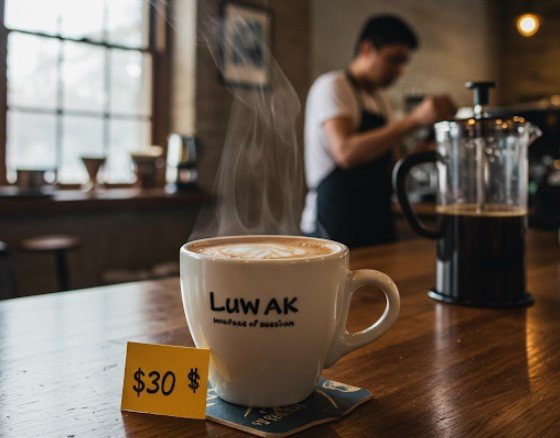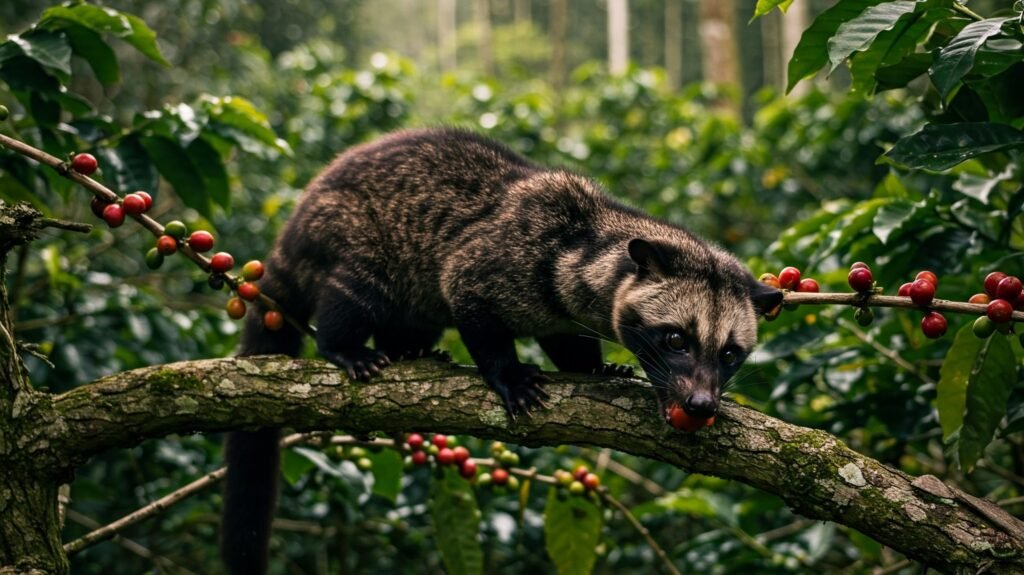Luwak coffee, also known as civet coffee, holds a unique and often controversial place in the world of specialty beverages. Its extraordinary production process, involving the Asian palm civet digesting coffee cherries, contributes to its rarity and, consequently, its high price tag. For coffee aficionados seeking a truly distinctive experience, a cup of Luwak coffee represents not just a caffeine fix, but a taste of the exotic and the unusual. However, the cost of this luxury varies significantly across the globe, influenced by a multitude of factors. This article delves into the price of Luwak coffee per cup in various countries, exploring the reasons behind these disparities and shedding light on the market for this intriguing brew.
What Makes Luwak Coffee So Expensive?
Before diving into the price breakdown, it’s crucial to understand why Luwak coffee commands such a premium. The primary reason lies in its unique production method. Asian palm civets, native to Southeast Asia, naturally consume ripe coffee cherries. During digestion, enzymes in their stomach break down certain proteins in the beans, purportedly altering the flavor profile. The civets then excrete the undigested beans, which are collected, cleaned, roasted, and finally brewed.
This natural selection and enzymatic process are believed to impart a smoother, less bitter taste to the coffee, with notes of chocolate and caramel. However, the scarcity of wild civet droppings and the labor-intensive collection process contribute significantly to the high cost of authentic Luwak coffee.
Furthermore, the demand for this novelty coffee, particularly in Western markets and among affluent consumers, further drives up the price. The mystique surrounding its origin and the perceived exclusivity add to its allure.
Factors Influencing the Price Per Cup
Several factors contribute to the variation in Luwak coffee prices across different countries:
- Source of the Beans: Indonesia is the primary source of Luwak coffee, followed by other Southeast Asian countries like Vietnam, the Philippines, and Thailand. The closer a country is to the source, the potentially lower the cost of the raw beans. However, even within these regions, prices can vary depending on the specific origin and the conditions of production (wild-sourced vs. farmed).
- Import and Export Costs: Transportation, tariffs, and other import/export fees can significantly impact the final price in countries far from the origin.
- Retailer Markup: Cafes, specialty coffee shops, and online retailers will add their own markup to cover operational costs, rent, labor, and profit margins. This markup can vary considerably depending on the location, the prestige of the establishment, and the perceived value of the product.
- Demand and Supply: In countries where Luwak coffee is highly sought after but supply is limited, prices will naturally be higher. Conversely, in regions closer to the source or where demand is lower, prices might be more competitive.
- Authenticity Concerns: The high price of Luwak coffee has led to the emergence of counterfeit products. In some countries, particularly those with less stringent regulations, it can be challenging to guarantee the authenticity of the beans, potentially affecting the perceived value and price.
- Ethical Considerations: Growing awareness of the ethical concerns surrounding caged civet farming has led some consumers to seek out and pay a premium for wild-sourced, ethically produced Luwak coffee. This can influence the price in markets where ethical sourcing is a priority.
- Currency Exchange Rates: Fluctuations in currency exchange rates can also affect the price of imported goods like Luwak coffee.
Price of Luwak Coffee Per Cup: A Country-by-Country Overview
It’s important to note that obtaining precise, up-to-the-minute figures for every country can be challenging due to the dynamic nature of the market and the varying levels of availability. However, based on available information from specialty coffee retailers, news articles, and market reports, we can provide a general overview of the price range in different regions:
Indonesia (Source Country):
Being the primary origin, Indonesia generally offers the most affordable authentic Luwak coffee. While prices can vary between tourist-oriented cafes and local establishments, a cup of wild-sourced Luwak coffee in Indonesia can range from IDR 50,000 to IDR 200,000 (approximately USD 3.50 to USD 14). Farmed Luwak coffee might be slightly cheaper, but ethical concerns often steer discerning consumers towards wild-sourced options.
United States:
In the United States, Luwak coffee is considered a high-end luxury item. A single cup in a specialty coffee shop or through online retailers can range from USD 30 to USD 100 or even higher. The high import costs, retailer markup, and the perceived exclusivity contribute to this steep price. Online retailers often offer smaller quantities of beans for home brewing at a premium per serving.
United Kingdom:
Similar to the US, the UK market for Luwak coffee sees prices ranging from GBP 20 to GBP 70 (approximately USD 25 to USD 88) per cup. High-end department stores and online specialty coffee suppliers are the primary sources. The cost reflects import duties, retailer margins, and the demand for unique and luxurious coffee experiences.
Japan:
Japan has a sophisticated coffee culture and a penchant for high-quality and rare products. A cup of Luwak coffee in a specialty cafe in Japan can cost anywhere from JPY 3,000 to JPY 10,000 (approximately USD 20 to USD 67). The emphasis on quality and the willingness of Japanese consumers to pay for premium experiences contribute to these prices.
Australia:
In Australia, a cup of Luwak coffee can set you back between AUD 30 to AUD 80 (approximately USD 20 to USD 53). Specialty coffee roasters and cafes in major cities are the most likely places to find it. The relatively high cost of living and the demand for premium coffee contribute to the price range.
Canada:
Canadian prices for Luwak coffee per cup generally fall within the range of CAD 30 to CAD 100 (approximately USD 22 to USD 73). Similar to the US, import costs and retailer markups play a significant role in the final price.
Singapore:
Being a hub for international trade and with a discerning consumer base, Singapore offers Luwak coffee at prices ranging from SGD 25 to SGD 70 (approximately USD 19 to USD 52) per cup. High-end cafes and gourmet food stores are the typical vendors.
Switzerland:
Known for its high cost of living and appreciation for luxury goods, Switzerland sees Luwak coffee prices ranging from CHF 30 to CHF 90 (approximately USD 33 to USD 100) per cup. Exclusive cafes and specialty retailers cater to a niche market willing to pay a premium for this unique beverage.
Regional Variations Within Countries:
It’s important to remember that these are general price ranges. Within each country, the price of a cup of Luwak coffee can vary significantly based on the specific location, the type of establishment (e.g., a high-end hotel vs. a small cafe), and the specific blend or grade of the coffee. Tourist hotspots often have inflated prices compared to local establishments.
Where to Find Luwak Coffee:
Luwak coffee is typically found in:
- Specialty Coffee Shops: These establishments often curate a selection of rare and exotic coffees, including Luwak.
- High-End Department Stores: Some luxury department stores with gourmet food sections may offer brewed Luwak coffee or sell the beans.
- Online Retailers: Numerous online retailers specialize in selling premium coffees, including Luwak, often offering beans from specific origins.
- Luxury Hotels and Resorts: Some high-end hotels and resorts, particularly in regions popular with affluent travelers, may offer Luwak coffee as a premium beverage option.
- Directly from Producers (with caution): In some cases, it might be possible to purchase Luwak coffee directly from producers in Southeast Asia. However, ensuring authenticity and ethical sourcing is crucial in such transactions.
Ethical Considerations:
While the allure of Luwak coffee is undeniable, it’s essential to address the ethical concerns surrounding its production. The high demand has led to the proliferation of caged civet farms where the animals are often kept in inhumane conditions and force-fed coffee cherries. This practice raises serious animal welfare issues.
Consumers who wish to try Luwak coffee should prioritize purchasing wild-sourced and ethically produced beans. These beans are collected from the natural droppings of wild civets, ensuring the animals’ well-being. Reputable retailers and producers will often provide information about their sourcing practices. Organizations like the World Animal Protection have raised awareness about the cruel practices in some civet farms, urging consumers to make informed and ethical choices.
The price of Luwak coffee per cup varies dramatically across the globe, reflecting a complex interplay of factors including origin, import costs, retailer markups, demand, and ethical considerations. From the relatively affordable prices in its native Indonesia to the exorbitant costs in Western markets like the United States and Europe, a cup of this unique brew remains a luxury for most. While the experience may be intriguing for coffee enthusiasts, it’s crucial to be aware of the ethical implications and to seek out responsibly sourced Luwak coffee to ensure that this exotic indulgence doesn’t come at the cost of animal welfare. Ultimately, the price of Luwak coffee is not just about the cost of the beans, but also about the journey they take and the story they tell, a story that consumers should explore with both curiosity and conscience.



